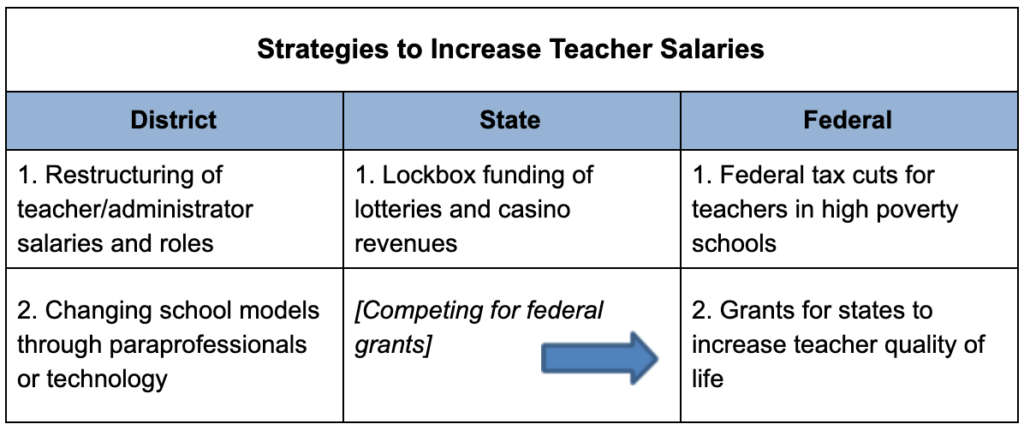In this two-part series, Julie Crookston and Salimah Jasani dissect the issue of teacher pay in the United States. This second piece considers different options for increasing teacher pay in the United States. (See Part I, Why Give Teachers Raises?)
___
Options for Increasing Teacher Pay
While it is widely accepted that teacher salaries should be higher, the common belief is that increasing salaries is politically infeasible or simply too expensive. The reality, however, is that there are several different options for funding salary increases at every level of the education system: district, state, and federal. A number of strategies have emerged, such as restructuring teacher and administrator salaries and roles, changing school models through paraprofessionals and technology, lockbox funding of state lottery and casino revenues, federal tax cuts for teachers in high poverty schools, and grants for states to increase teacher quality of life. Figure 1 depicts the relationship between all of these strategies.

Figure 1
District-Level Options: Restructuring School Models
Most school districts have a policy of paying administrators higher salaries than teachers. The Bureau of Labor Statistics reports that in 2017 the average school principal made $94,390. This is consistent with the corporate culture of higher pay for seniority and management, yet the goals of a corporate entity and a school are vastly different. The mission of a school is to educate children, and in this arena, teachers have the potential for the greatest impact. Unfortunately, with the current system, there is an unwritten culture that incentivizes teachers to leave the classroom to pursue roles as administrators in order to make a higher salary.
Innovative models exist to increase teacher pay without increasing overall education spending.
Restructuring of teacher/administrator salaries and roles. One is the restructuring of teacher and administrator roles to create teacher/administrator hybrid roles. A salary restructure would follow along with the restructuring of responsibilities, thus evening out the pay gap between teachers and administrators. One school in New York that follows this model is able to pay its teachers $125,000 a year using normal state funding.
Changing school models through paraprofessionals or technology. The Multi-Classroom Leadership model creates teams of teachers that are led by a teacher-leader. These teacher-leaders manage training, collaboration, planning, and specific roles to team teachers. Less experienced teachers’ roles could be adjusted to only require 40 hours of work a week (instead of the average 50 hours) for lower pay, but with the opportunity to get paid substantially more with experience.
Another model has elementary school teachers specializing in specific subjects and hires paraprofessionals to do the grading. A third model uses technology to give students self-paced instruction when they are not in class with a teacher. Fewer teachers are needed to maintain current class sizes, leading to an increase in pay for all teachers. All of these models have been shown to increase teacher pay over 40 percent without the need for additional government funding of schools.
State-Level Option: Earmarked Lottery Revenue and “Lockbox” Funding
Lockbox funding of lottery and casino revenues. As of 2005, 40 states and the District of Columbia operated lotteries, with many states earmarking a certain portion of lottery profits to go toward increased education funding. However, most states do not have any mechanisms in place to keep lottery funds from supplanting, rather than supplementing, education funding. In fact, states with lotteries actually use a smaller percentage of their wealth to pay for school funding than states without lotteries. The status quo is misleading to constituents and detrimental to public education.
Fortunately, citizens are starting to recognize that lottery funding has not led to an increase in education funding and are initiating change. For example, this past November, residents of Maryland voted on a ballot measure to create a constitutional amendment requiring a portion of casino funding to supplement, rather than supplant, education spending. The popularity of this so-called “Lockbox Amendment” indicates that people want to see earmarked education funding lead to an increase in spending on schools. Thus, one way to increase teacher salaries would be to put a percentage of lottery and casino profits in a “lockbox” for education, and specifically for increased teacher pay. Politically, this option is more viable now than ever before due to heightened awareness. There is already momentum toward changing the system; states should use this momentum to ensure their teachers earn a higher salary.
Federal-Level Options: Tax Breaks for Teachers and Federal Incentives to States
Currently, the scope of federal intervention in education funding is limited in the United States. However, countries like Singapore and the United Kingdom, which have recently implemented national strategies to maintain adequate teacher pay, have found success in increasing not only teacher pay but also teacher quality. Additionally, the U.S. federal government has historically intervened in education as it relates to specific student populations, particularly children living in poverty. Given that teachers working in high-poverty schools make $41,00 less than those working in low-poverty schools, it would be justified for the federal government to intervene in order to increase teacher compensation.
Federal tax cuts for teachers in high-poverty schools. One idea put forth by the Center for American Progress would create an incremental $10,000 refundable Teacher Tax Credit for teachers in high-poverty schools. This proposal would cost about $15 billion annually, which is approximately how much the federal government currently spends on supplementing doctor training funds. In other words, there is a precedent for federal funding and intervention in the growth and well-being of a particular profession.
Grants for states to increase teacher quality of life. Another means of federal intervention would be to use federal grants through the Department of Education’s Academic Improvement and Teacher Quality initiative (AITQ) to incentivize states to raise teacher salaries. By dedicating a portion of its grant funding to states who have demonstrated that they have increased teacher pay (and thus, their quality), the federal government can prioritize increasing teacher pay without having to subsidize it completely. This option would look similar to the federal Race to the Top initiative, which invited states to compete for federal grants if they could demonstrate that they met certain standards in education reform.
Not only is there a precedent for federal intervention in education, but there is also a need for a message from the federal level that teacher pay needs to be increased, and that there are a number of ways to accomplish this goal.
Conclusion
Given the tremendous impact that teacher pay has on student performance, our economy, and our national security, policymakers at every level of the system would be remiss not to take steps to increase teacher pay nationwide. Indeed, the most effective way to achieve higher salaries would be for school districts, states, and the federal government to share the structural and economic burden. Specifically, we recommend implementation of all of these strategies in order to have the greatest net benefit for our teachers and students.
At the very least, implementing even one of the many strategies above would result in higher pay for teachers and, consequently, a better future for our children and for our country itself. That being said, we recognize that the most politically feasible option, and the one with the most immediate potential effect, would be for school districts to restructure teacher, paraprofessional, and technology roles in their systems. Thus, we recommend that this be the first area of focus in the short run. In the long run, the strategy with the greatest potential to create lasting change and send a clear message about the importance of our teachers would be for the federal government to implement a tax cut for teachers in high poverty schools.
What is clear is that the status quo is not acceptable. In order to protect our national interest and create a future workforce of capable and educated citizens, it is essential that we take steps to increase teacher salaries.
___

Salimah Jasani is a candidate for the Master of Public Affairs (DC Concentration) at the LBJ School. Prior to joining this program, Salimah taught Special Education English at the high school level for four years in Baltimore. She is the co-founder and co-host of the Point of Hue podcast, which seeks to amplify the voices of women of color creating positive social change. Her policy interests are in K-12 education policy and disability advocacy.

Julie Crookston is a candidate for the Master of Public Affairs at the LBJ School. After completing her undergrad, Julie taught Junior High mathematics for 2 years before coming to Austin and joining the AmeriCorps. Through AmeriCorps she worked with a local non profit, College Forward, before being accepted into the LBJ School. Her policy interests are non-profits, education, and city government.

